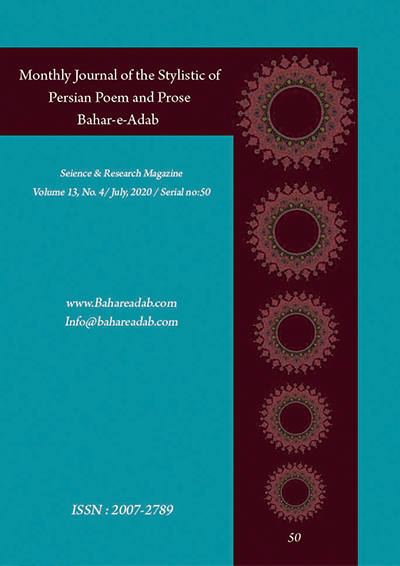- Count View : 601
- آدرس کوتاه شده مقاله: https://bahareadab.com/article_id/361
Journal of the stylistic of Persian poem and prose
volume Number 13،
number In Volume 4،
،
issue Number 50
The reflection parable and allegorie and its function at thousand and one night
Shokoufeh Mohammadi Raighani, Mohammad Hakimazar(Author in Charge), Hossein Khosravi
Abstract
Thousand and one nights, including our legendary books and the Islamic world in the field of oral and folk literature, in addition to the range of meaning and content, a wide variety of events, events and various personalities, beautiful testimonies and literary industries, The combination of order and prose ... is an important source for the folk parables and idioms used in everyday interactions and conversations of that era. In this research, the author seeks to extract, categorize, analyze the frequency of types of parables in this book. For this purpose, the parables have been examined from different perspectives such as: narrative and descriptive, content, and orientation of parables, themes and heroes of allegories, Arabic and Persian parables, and the division of parable on Professor Bahman Yar, showing their frequency through the graph. The findings of the research show that 65 percent of the allegories are descriptive and about 72 percent of the parliaments are Persian, as well as more orientation of the parables from the descriptive and normative species, most of the book"s parable are prose, allegory and hero. 71 percent of the allegorical parables are the human type.
Keyword
parable
, allegories
, thousand one night
, Tassoi
- Mansour Moayed, Alireza (1997), Sending a Proverb in Masnavi, Tehran: Soroush
- Sattari, Jalal (1989), Afsoon Shahrzad, Research in Hezar Afsoon, Tehran: Toos
- Injou Shirazi, Abolghasem (1973), Allegory and Proverb, Tehran: Amirkabir
- Zolfaghari, H. (2007), Reflection of Social Issues in Persian Proverbs, Najva Magazine, No. 3, p. 15
- Fotouhi, Mahmoud (2014), Picture Rhetoric, Tehran: Sokhan
- Shamisa, Sirus (1370), Bayan, Tehran: Ferdows
- Khorasani, M. and Mazdapour, K. and Zanobi, 2010 (2010), Structural analysis of women's trickery in the tales of One Thousand and One Nights, Journal of Literary Research, No. 29, p. 9
- Irwin, Robert (2010), An Analysis of One Thousand and One Nights, translated by Fereydoon Badraei, Tehran: Farzan
- Zolfaghari, H. (2007), The difference between proverbs and some similar literary and linguistic genres, Research and Cultural QuarterlyWhisper of Culture, No. 4
- Khayali Khatibi, A (2006), Allegory in Persian Literature, Kayhan Farhangi Magazine, No. 241, p. 53
- Mollai, Gh (2004), Allegory in Iranian and World Literature, including the Growth of Persian Language and Literature Education, No. 70, p. 56
- Shiri, AH (2010), Allegory and New Image of Functions and Its Types, Kavshanameh Quarterly, No. 20, p. 54
- Anju Shirazi, Abolghasem (1973), Allegory and Proverb, Tehran: Amirkabir
- Zargramini, Gh (2007), The Attraction and Enchantment of One Thousand and One Nights, Roudaki Magazine, No. 16, p. 34
- Samini, N (1997), Dramatic aspects of One Thousand and One Nights, Art Magazine, No. 34, p. 84
- Ebrahimi, Sh (2009), Women's Remedy in One Thousand and One Nights, Bahar Adab Magazine, Year 2, Issue 2, Page 125
- Bahmanyar, Ahmad (2002), Bahmanyari storybook, Tehran: University of Tehran
- Shakurzadeh, Ebrahim (2011), Twelve thousand Persian proverbs and thirty thousand equivalent, Tehran:Beh nashr
- Pournamdarian, Taghi (2012), Mysteries and Mysterious Stories in Persian Literature, Tehran:Elmi va Farhangi
- Partovi Amoli, Mehdi (2012), Historical Roots of Proverbs and Verdicts, Tehran: Sanaei
- Hamidi, J. and Shamian, A. (2005), The origin of the development of allegories, Journal of the Faculty of Literature, University of Tabriz, p.75
- Sepehr, Fereshteh (2013), Sarahi Maynab, Tehran:Ketabdar
- Shafiee Kadkani, Mohammad Reza (1987), Imagination in Persian Poetry, Tehran: Agah
- Jamshidipour, Yousef (1347), Culture of Persian Proverbs, Tehran: Foroughi
- Homayi, Jalaluddin (1987), Rhetoric and Literary Crafts, Tehran: Homa
- Borghei, Seydihi (1985), Exploring Persian Proverbs and Verdicts, Qom: Book Publishing Exhibition
- Parsa, A (2005), Proverbs from a New Perspective, Journal of Persian Language and Literature Education, No. 75, p. 4

